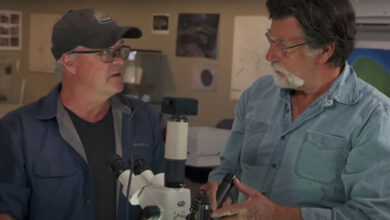New Oak Island Horrifying Theories That Are ACTUALLY Happening Right Now!
New Oak Island Horrifying Theories That Are ACTUALLY Happening Right Now!

The mystery of Oak Island has fascinated treasure hunters and historians for over two centuries. Located off the coast of Nova Scotia, Canada, this small island is rumored to conceal buried treasures and secrets dating back hundreds of years. The popular TV show “The Curse of Oak Island” has brought this enigma into the living rooms of viewers worldwide, showcasing the efforts of the Lagina brothers and their team as they explore the island’s mysteries.
Among the most captivating theories explored in the series is the idea that the Aztec civilization might have had connections to Oak Island. This theory suggests that the Aztecs, renowned for their extensive empire and advanced societal structures in what is now Central Mexico, ventured as far north as Nova Scotia. The speculation is based on the Aztecs’ supposed interest in a specific type of blue clay found on the island—a material believed to be more valuable to them than gold due to its use in pottery and spiritual significance.
In many ancient cultures, certain natural resources held more than just economic value; they bore spiritual and symbolic meanings. For the Aztecs, materials used in their pottery were chosen not only for their physical properties but also for their cultural and spiritual symbolism. This blue clay might have been sought after for these deeper, metaphysical properties, playing a role in religious ceremonies or in the creation of sacred objects. The idea that the Aztecs could have valued this clay more than gold provides fascinating insights into their priorities and cultural practices.
The theory suggests that the Aztecs established a mining operation on Oak Island to extract this precious clay. This would indicate not only advanced long-distance navigation but also the initiative to exploit distant resources. The South Shore shaft, mentioned in the series, is proposed as an initial mining site developed by the Aztecs, implying a level of technological and organizational skill consistent with historical records of the Aztec Empire.
However, this theory remains speculative with no concrete evidence confirming the presence of the Aztecs on Oak Island. The connection relies on circumstantial evidence and expert speculation rather than direct archaeological findings. For instance, interpretations of the purpose and origin of the South Shore shaft could have multiple explanations. The absence of definitive archaeological artifacts, such as Aztec tools, pottery, or genetic traces, makes the theory less convincing in the scientific community. Additionally, the historical timeline and known travel capabilities of the Aztec civilization do not typically include voyages to Nova Scotia, adding another layer of doubt.
If future investigations were to validate the presence of Aztecs on Oak Island, the implications would be profound. It would radically alter our understanding of pre-Columbian trans-Atlantic contact and suggest that the Aztecs were far more advanced in their navigational techniques than previously thought. Such a discovery would expand our knowledge of the trade and cultural exchange networks of the time, illustrating a previously unimagined level of interaction between distant cultures. It would also add a rich, complex layer to the island’s history, suggesting that its mystery could be even more multifaceted than existing legends indicate.
Another intriguing theory introduced by Alan Butler is the Enochian Chamber hypothesis. This theory proposes that the infamous Money Pit, the central point of interest on Oak Island, was deliberately constructed to mirror Solomon’s Temple. According to the theory, the chambers within the pit are similar to those described in Enochian traditions—mystical rites linked to spiritual artifacts like the Ark of the Covenant.
The theory suggests that the Money Pit’s design extends beyond mere treasure concealment to reflect a sacred model—Solomon’s Temple. This biblical structure was not only the crowning glory of King Solomon’s reign but also a symbol of divine interaction with humanity, housing the original Ark of the Covenant. If the Money Pit was intended as a similar sacred space, it might have been created to safeguard holy or magical artifacts.
Central to this theory are the Enochian traditions, involving magical practices revealed to John Dee and Edward Kelley in the 16th century. Dee and Kelley developed the Enochian language, claiming it was revealed by angels and held immense magical powers. The theory suggests that the chambers within the Money Pit were designed for conducting magical rites and that their strategic alignment at specific compass points indicates a sophisticated understanding of earthly and celestial geometries—crucial for Enochian magical practices.
Despite its rich historical and mystical allure, the Enochian Chamber theory faces significant skepticism due to its speculative nature. No concrete evidence directly supports the existence of Enochian chambers beneath Oak Island, nor is there archaeological evidence of the elaborate construction that would mirror Solomon’s Temple. The theory relies on the assumption that individuals with knowledge of Enochian traditions would have traveled to Oak Island and constructed these chambers, which presents logistical challenges and lacks direct documentary evidence.
If evidence were to emerge supporting the Enochian Chamber theory, it would profoundly alter our understanding of pre-modern spiritual practices and their reach. It would suggest a previously unimagined connection between Renaissance Europe’s esoteric traditions and remote North American locales. This would also shift the narrative of Oak Island from a treasure trove to a site of profound spiritual and magical importance.
The theory linking American Founding Fathers Benjamin Franklin and Thomas Jefferson to Oak Island introduces a dramatic and patriotic twist. This conjecture suggests that their involvement with the island could have been part of a secretive mission crucial to the early United States. Although captivating, this theory remains speculative and lacks substantial evidence.
Benjamin Franklin and Thomas Jefferson were notable figures in American history, known for their diverse contributions in science, literature, and philosophy. The theory posits that these polymaths, with their intellectual curiosity and involvement in secretive societies like the Freemasons, might have seen Oak Island as a strategic location for hiding important historical artifacts or documents. These could include items of significant cultural value or sensitive materials meant to be kept from European powers or hidden from certain factions within the growing United States.
However, connections between Franklin or Jefferson and Oak Island are tenuous at best. There is no documented evidence linking these Founding Fathers to the island or any activities there. The theory is based on their known involvement in Masonic activities and their engagement in intellectual and political movements, which some speculate might have included covert operations.
Moreover, both Franklin and Jefferson were public figures deeply involved in political and scientific advancements, making it impractical to believe they could have dedicated significant time and resources to an obscure island in Nova Scotia. The logistics of such an endeavor—traveling, securing, and hiding items—would have been considerable and difficult to conceal.
Despite the lack of concrete evidence, the theory captivates the public for several reasons. It ties the Oak Island mystery to revered historical figures, blending the allure of hidden treasures with the respectability of national heroes. This theory taps into the romantic notion of the Founding Fathers engaging in mysterious activities that hint at a deeper, possibly unrevealed layer of early American history. It serves to stimulate curiosity and debate rather than provide definitive answers.
The theories connecting the Knights Templar and Freemasons to Oak Island are among the most enduring and captivating legends. These theories propose that the Templars, after fleeing persecution in Europe, chose Oak Island as a secret repository for their sacred relics or treasures. This narrative is supported by various symbols and markings on the island that some interpret as having Masonic significance.
The Knights Templar, a medieval Christian military order, was founded in the early 12th century to protect Christian pilgrims traveling to the Holy Land. By the 14th century, they faced persecution from the French monarchy and the Catholic Church, leading to their dissolution and the execution of many members. Freemasonry, evolving from stonemason guilds, became a more secretive organization incorporating rituals and symbols, some of which are believed to be influenced by Templar traditions.
The theory suggests that the Templars, possessing vast wealth and the means for secretive global missions, might have transported their treasures to Oak Island to protect them from their enemies. This theory is fueled by the presence of symbols on the island interpreted as clues left by the Templars or as coded messages indicating hidden treasures.
Freemasonry’s connection to Oak Island is based on interpretations of symbols and the organization’s historical preference for ritual and secrecy. Some speculate that Freemasons visited the island to deposit sacred items or inherited the Templar legacy, choosing Oak Island as a new secret storage site.
Despite their appeal, these theories face significant challenges in terms of verifiable evidence. Archaeological and historical investigations on Oak Island have yet to prove conclusively the presence of Templar or Masonic activities. Many supposed symbols may be coincidental or misinterpreted, and the historical timeline and logistics of Templars or Freemasons choosing an obscure island for their artifacts are complex and speculative.
The Money Pit on Oak Island represents the epicenter of the island’s mysteries and legends. Discovered in the late 1700s, this deep and complex structure has captivated treasure hunters with its elaborate booby traps and sophisticated flooding mechanisms. These features suggest that whoever constructed the pit went to great lengths to protect its contents, fueling speculation about the invaluable treasures hidden within.
The Money Pit was first discovered by teenagers who found a depression in the ground while exploring Oak Island. Subsequent excavations revealed a shaft with timber platforms at regular intervals. The pit’s flooding, which suggested intentionally designed flood tunnels connected to the beach, has been a major obstacle for treasure seekers, indicating a level of premeditated engineering meant to protect the pit’s secrets.
Numerous theories propose who might have constructed the Money Pit and why. Some suggest pirates hiding looted riches, others point to treasures from the Knights Templar, or even deposits from the British military during the colonial era. Each theory offers exciting possibilities about the origins of the pit and its potential contents.
Recent years have seen the Money Pit become the focus of “The Curse of Oak Island,” a TV series following the Lagina brothers as they use modern technology and historical research to uncover its secrets. Despite advanced drilling techniques, sonar mapping, and diving equipment, the Money Pit continues to guard its secrets jealously, with each attempt to penetrate its depths facing




